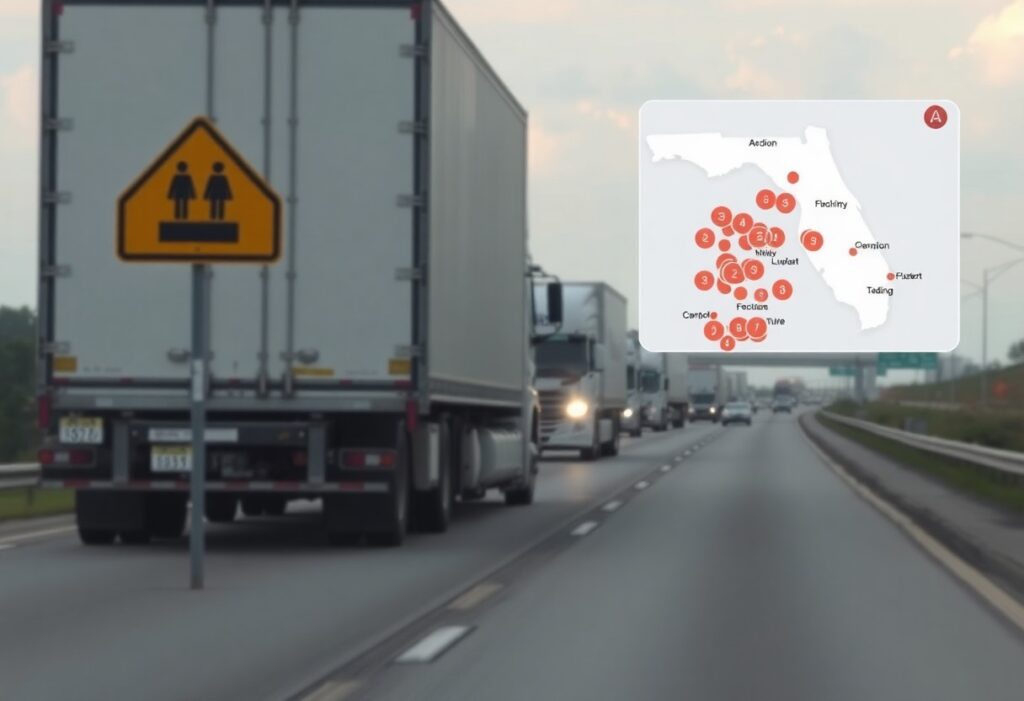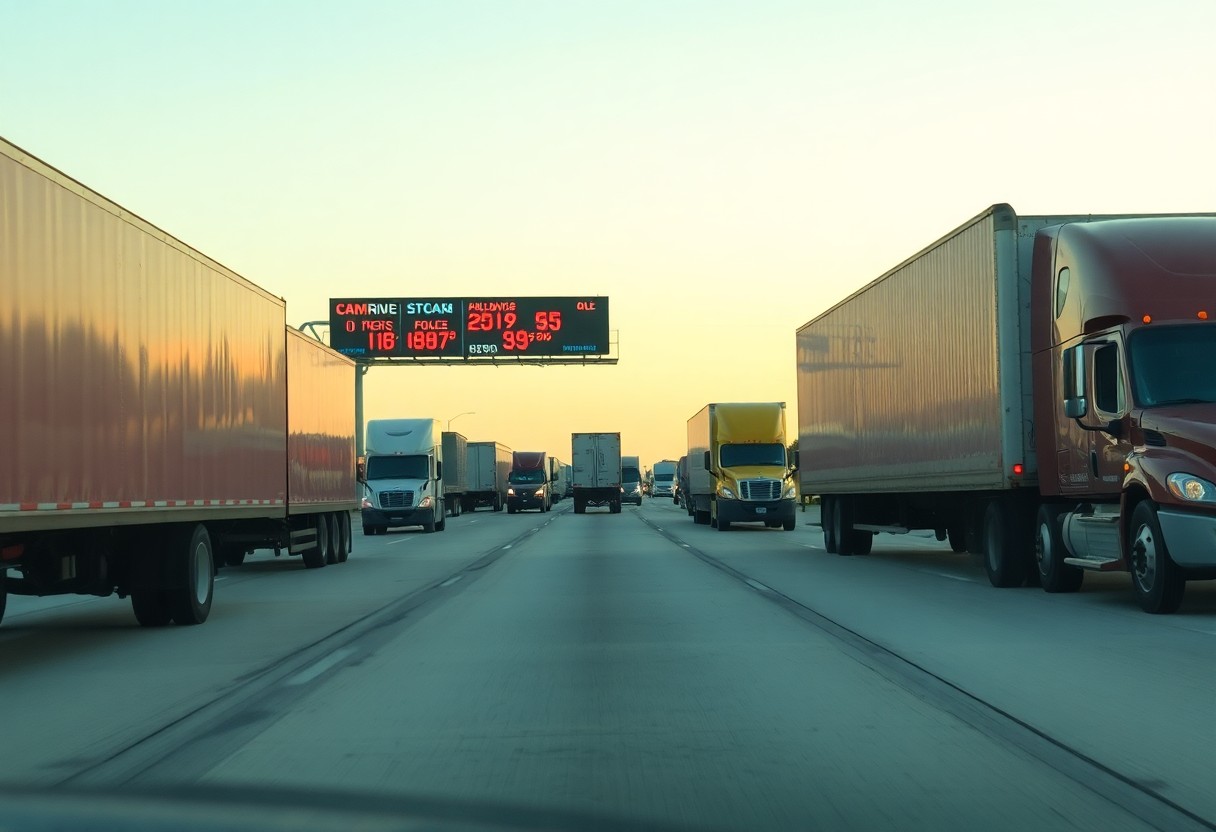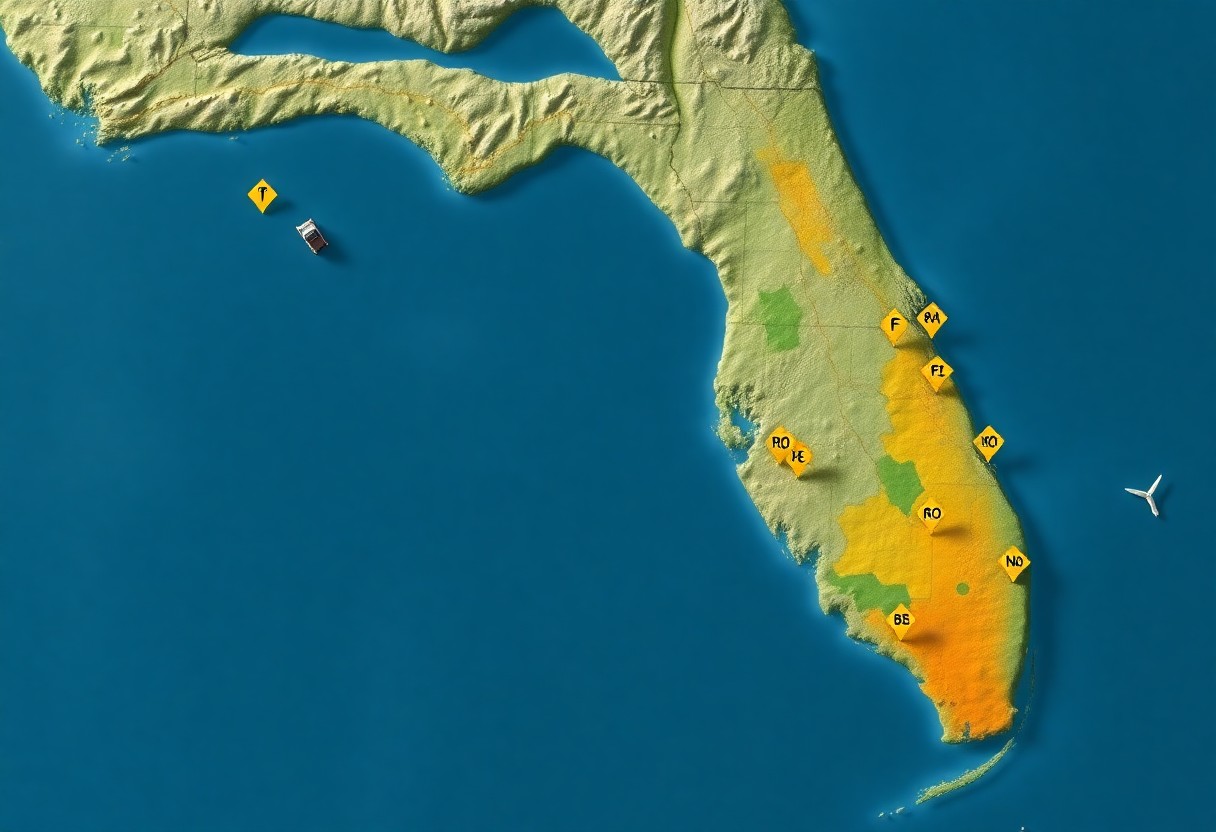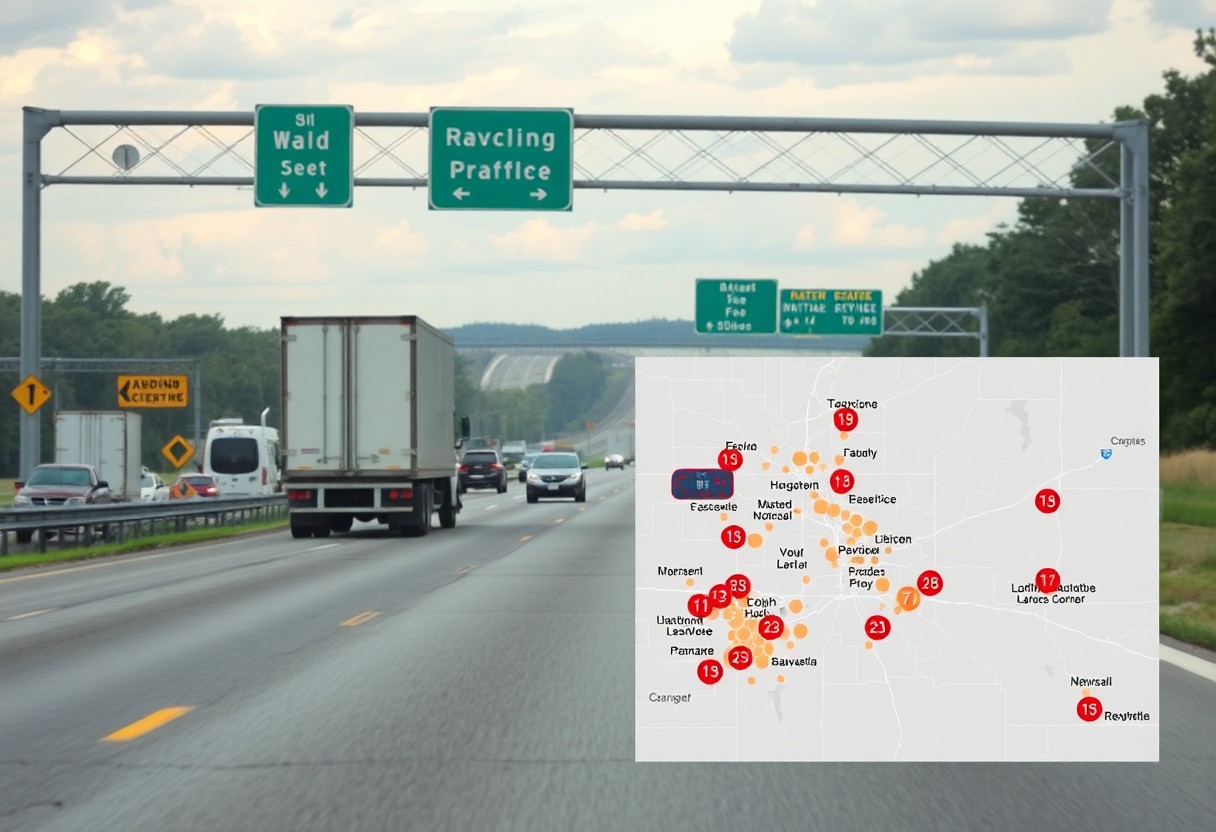With the bustling highways of Florida serving as a lifeline for travel and commerce, it’s vital you stay informed about the significant risks posed by truck accidents. From high traffic volumes to specific hotspots known for their perilous conditions, your safety on these roads can be compromised if you’re unprepared. This post will guide you through the key locations where truck accidents frequently occur, equipping you with the knowledge you need to navigate Florida’s roads more safely and avoid potential accidents.
Key Takeaways:
- Truck Accident Hotspots: Certain areas in Florida have been identified as high-risk locations for truck accidents, necessitating increased awareness and caution from drivers.
- Infrastructure Challenges: Many highways exhibit inadequate infrastructure, which contributes to the frequency of truck-related incidents, highlighting the need for improvements.
- Driver Behavior: Unsafe driving practices among both truck operators and passenger vehicles can escalate the likelihood of accidents, emphasizing the importance of safe driving habits.
Overview of Florida’s Highway System
Before exploring the specific dangers present on Florida’s highways, it’s crucial to understand the state’s expansive highway system. Florida boasts over 12,000 miles of roadways, including interstates, highways, and expressways that serve as vital arteries for transportation and commerce. These roads cater to millions of residents and tourists alike, contributing significantly to the state’s economy while presenting specific risks.
Major Highways and Interstates
Any discussion about Florida’s highways must mention the extensive network of major interstates and highways. The most significant of these include I-75, I-95, and I-4, which connect large metropolitan areas and facilitate the movement of goods and people throughout the state. These busy routes are particularly susceptible to high traffic volumes and accidents.
Traffic Volume and Patterns
Traffic patterns in Florida are influenced by a range of factors such as tourism, seasonal migrations, and urban development. High tourist influx during peak seasons raises the risk of collisions, especially in popular destinations like Orlando and Miami. Additionally, you may encounter significant congestion during rush hours, leading to potentially dangerous driving conditions.
With a state so reliant on tourism, you will notice that traffic volume surges significantly during the winter months when seasonal residents flock to the region. This influx increases not only the number of vehicles on the roads but also contributes to diverse driver behaviors that can lead to accidents. Additionally, urban sprawl results in more cars on the roadways, leading to higher chances of collision. Increased awareness of these patterns can help you navigate Florida’s highways more safely.
Understanding Truck Accidents
There’s a pressing need to grasp the complexities surrounding truck accidents, especially given their unique risks on highways. The sheer size and weight of commercial trucks render them capable of causing significant damage and injuries in collisions. Understanding the specific factors that contribute to these incidents can help you stay vigilant and promote safer driving practices on Florida’s roadways.
Common Causes of Truck Accidents
To comprehend the frequency of truck accidents, it’s important to identify their common causes. Many incidents stem from factors such as driver fatigue, inadequate vehicle maintenance, and unsafe driving behaviors. Recognizing these issues can empower you to make informed decisions when sharing the road with large trucks.
The Impact of Cargo and Weight
Impact plays a significant role in truck accident dynamics, particularly regarding cargo and weight distribution. When a truck is overloaded or improperly loaded, it can drastically affect its handling and braking performance, increasing the likelihood of accidents.
Accidents involving trucks often occur due to issues related to their cargo weight and distribution. When trucks are overloaded, they require more stopping distance and can also experience >strong>stability issues while turning or maneuvering on the road. Inadequate securing of cargo can lead to cargo shifts, further compromising the truck’s balance and increasing the risk of rollovers or collisions. Being aware of these weight-related risks can help you understand the challenges truck drivers face and the potential dangers they pose to other motorists on Florida’s highways.
Identifying Truck Accident Hotspots
Your awareness of truck accident hotspots in Florida is vital for ensuring your safety on the road. With a high volume of commercial trucks navigating the state’s busy highways, you must recognize areas where accidents are more likely to occur. By understanding where these hotspots are, you can make more informed decisions while driving, potentially avoiding dangerous situations and contributing to safer roadways for everyone.
Top Locations for Truck Accidents in Florida
For anyone navigating Florida’s highways, certain locations have been identified as frequent sites of truck accidents. These hotspots are often densely populated with traffic, leading to increased risks for all drivers. Key areas include:
- I-95 corridor
- I-75 intersections
- I-4 stretch
- U.S. Highway 441
Thou must stay alert when driving through such regions.
Factors Contributing to Hotspot Areas
For you to understand why some areas are more prone to truck accidents, it’s crucial to analyze the contributing factors. These hotspots often face challenges such as:
- Heavy traffic congestion
- Inadequate road infrastructure
- Poor weather conditions
- Driver fatigue
Thou should prioritize safe driving behaviors, especially in these conditions.
Contributing to accident rates in Florida are significant elements that heighten the dangers of trucking on highways. Understanding these factors can help you navigate these areas wisely. These elements encompass:
- Poorly designed interchanges
- High truck traffic volume
- Inexperienced drivers
- Distracted driving
Thou will gain a better sense of self-awareness and safety by recognizing these risks on your journey.
Safety Measures and Regulations
Now, understanding the safety measures and regulations in place is crucial for navigating Florida’s bustling highways. While truck accidents can happen, awareness of these safety protocols can help protect you and your loved ones. Regulations are designed to promote safe driving practices among truck drivers and companies, highlighting their responsibility for the well-being of everyone on the road.
Florida’s Trucking Regulations
To ensure safer travel on Florida’s highways, the state has implemented strict trucking regulations. These rules cover everything from driver qualifications and hours of service to vehicle maintenance requirements. Compliance is monitored to minimize the risks associated with large commercial vehicles, ultimately aiming to reduce accidents.
Industry Best Practices for Safety
For trucking companies, adopting industry best practices for safety is vital. This involves thorough training programs for drivers, implementing regular vehicle inspections, and utilizing advanced safety technologies like collision avoidance systems. These practices not only contribute to safer highways but also enhance your peace of mind as you travel.
Industry best practices focus on both proactive and reactive safety measures that can significantly impact accident rates. By employing comprehensive driver training initiatives, trucking companies help ensure that drivers are equipped with the knowledge and skills to handle unexpected situations on the road. Additionally, implementing regular inspections and maintenance routines on trucks helps identify potential hazards before they become dangerous failures. Furthermore, leveraging emerging technologies, such as lane departure warnings and emergency braking systems, enhances overall safety, fostering a more secure environment for you and your fellow travelers.
Strategies for Prevention
Not only can you protect yourself on Florida’s highways by being aware of potential truck accident hotspots, but you can also implement various strategies for prevention. These techniques involve understanding the risks, improving your defensive driving skills, and collaborating with local authorities to foster safer road conditions. Taking proactive steps in your driving habits can significantly reduce the chances of an accident.
Educating Drivers on Safe Practices
For many drivers, education on safe practices is vital. By participating in driver safety courses and workshops, you can learn effective techniques to navigate busy highways, recognize truck blind spots, and maintain safe following distances. The more you know, the better prepared you are to handle potential dangers.
Community Initiatives and Awareness Programs
Between schools, local businesses, and law enforcement agencies, communities can join forces to promote safer driving behaviors. Initiatives may include public service announcements, safety campaigns, and local workshops focusing on the importance of truck driver awareness and shared responsibility on the roads.
Awareness is necessary for fostering a culture of safety on the highways. Many communities are launching awareness programs that emphasize the risks associated with truck accidents and promote safe driving practices. These programs often involve collaboration between local law enforcement and community organizations, providing educational materials, workshops, and hands-on training sessions to equip you with the knowledge needed to stay safe. Participation in these initiatives not only helps you understand the dangers of the road but also empowers you to advocate for safer conditions within your community.
The Role of Technology in Enhancing Highway Safety
Keep your safety in mind as technology evolves on Florida’s highways. Enhanced measures are being implemented to reduce accidents and improve overall road safety. From real-time data collection to predictive analysis, technological advancements play a significant role in identifying and addressing potential hazards. By becoming aware of these innovations, you can better navigate Florida’s rapidly changing roadway landscape.
Smart Transportation Systems
Against the backdrop of increasing traffic volumes, Smart Transportation Systems (STS) utilize advanced technologies to monitor and manage highway conditions. By integrating various electronic devices, these systems enhance communication between vehicles and infrastructure, leading to improved traffic flow and safety. STS offer real-time data and alerts to drivers, minimizing the likelihood of accidents.
Advanced Driver Assistance Systems (ADAS)
By implementing Advanced Driver Assistance Systems (ADAS), you can significantly reduce the risk of accidents on Florida’s highways. These systems deliver automatic alerts and take corrective actions to prevent collisions. Features such as automatic emergency braking and lane departure warnings provide critical assistance for safe driving. As you explore the latest innovations, it is crucial to understand how ADAS can enhance your driving experience.
ADAS Features
| Feature | Description |
| Automatic Emergency Braking | Prevents collisions by applying brakes when necessary. |
| Lane Departure Warning | Alerts you when you unintentionally drift from your lane. |
| Blind Spot Monitoring | Informs you of vehicles in your blind spots. |
Systems like ADAS are rapidly evolving to include additional features that prioritize your safety. These cutting-edge technologies offer enhanced protection during your daily commutes or long-distance travels. With functionalities such as adaptive cruise control and rear cross-traffic alerts, the benefits of ADAS extend beyond mere convenience, actively working to reduce the likelihood of dangerous situations.
ADAS Benefits
| Benefit | Description |
| Accident Reduction | Minimizes the chances of collisions through alerts and interventions. |
| Increased Awareness | Enhances your situational awareness of surrounding vehicles. |
| Stress Reduction | Makes driving less stressful with automated assistance. |
Final Words
Considering all points, you must recognize the hidden dangers that Florida’s highways present, particularly in areas notorious for truck accidents. Understanding these hotspots is imperative for your safety and the safety of others on the road. By staying informed and practicing defensive driving techniques, you greatly reduce the risk of being involved in a collision. Your awareness of these dangerous locations can empower you to make safer choices while navigating Florida’s highways, ultimately contributing to a safer driving environment for everyone.
















